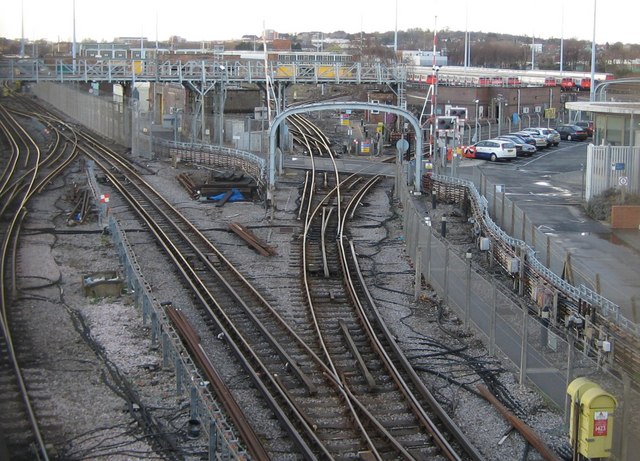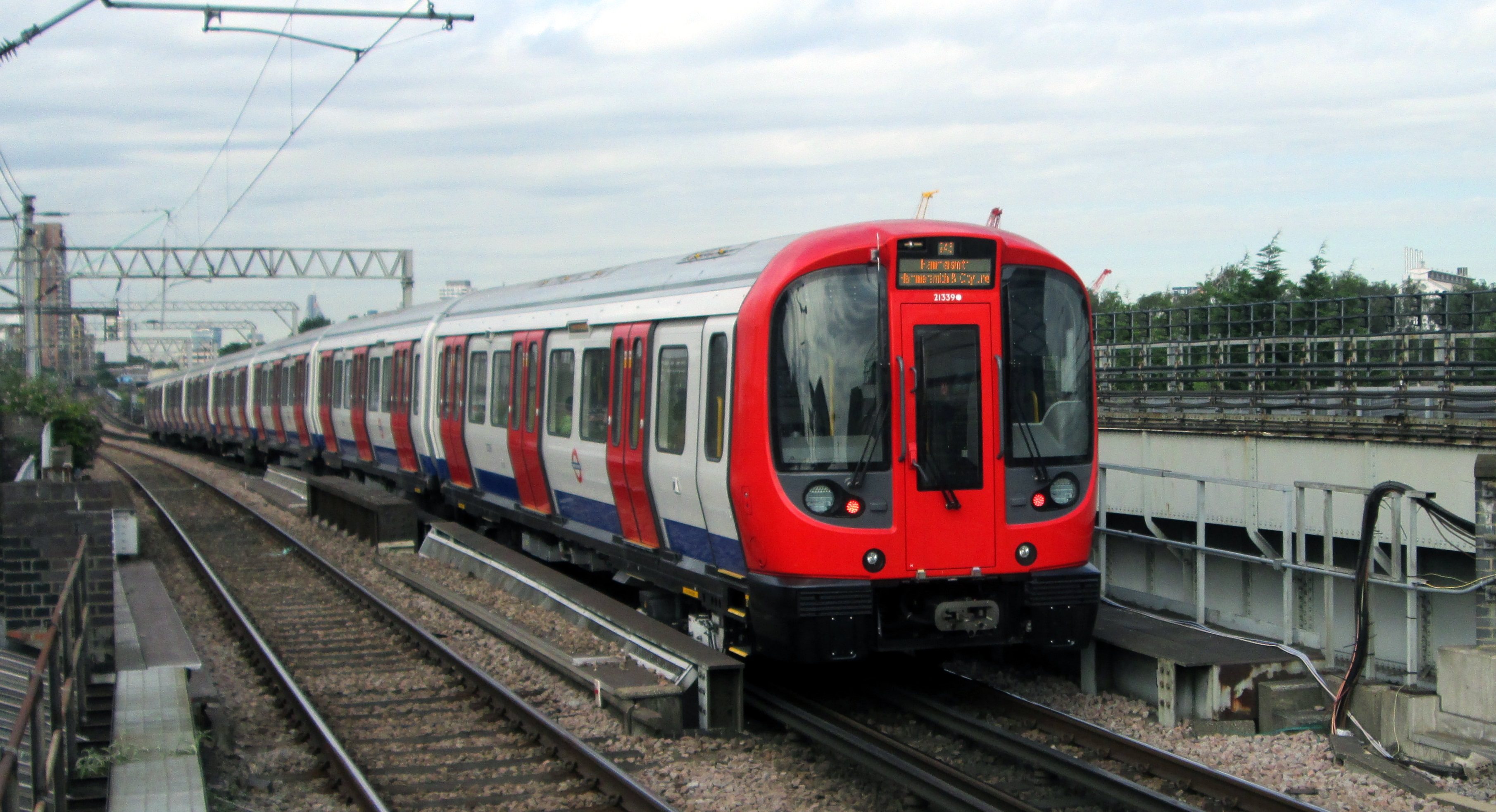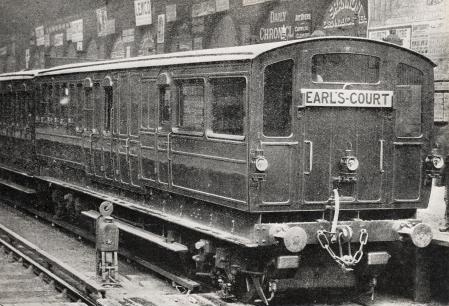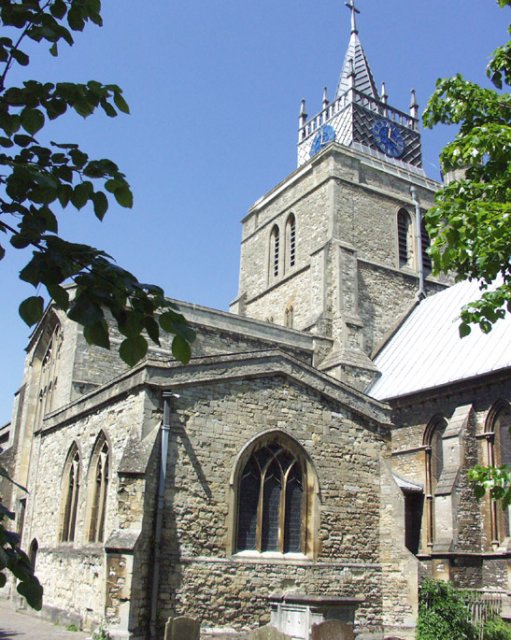|
Neasden Depot
Neasden Depot is a London Underground depot located in Neasden in the London Borough of Brent, between Neasden and Wembley Park stations on the Metropolitan line. It is the largest depot on the London Underground, and is currently responsible for maintenance and overhaul of the 191 S Stock trains used on the Circle, District, Hammersmith & City and Metropolitan lines. History Neasden was opened as a locomotive and coach plant in 1882, producing locomotives and coaching stock for the Metropolitan Railway. The final locomotive produced at the works was in 1898. The depot serviced both steam and electric Metropolitan locomotives. Major work was undertaken at Neasden between 2010 and 2011, with much of the 1930s layout being altered to make it suitable for maintenance of the S Stock, which began to be rolled out in 2010 to all London Underground Sub Surface lines. Due to the rebuild, Neasden's steam shed has now been decommissioned and converted into the Depot's training faci ... [...More Info...] [...Related Items...] OR: [Wikipedia] [Google] [Baidu] |
Neasden
Neasden is a suburban area in northwest London, England. It is located around the centre of the London Borough of Brent and is within the NW2 ( Cricklewood) and NW10 (Willesden) postal districts. Neasden is near Wembley Stadium, the Welsh Harp, and Gladstone Park; the reservoir and River Brent marks its boundaries with Kingsbury and Wembley, while Gladstone Park and the Dudding Hill line separates it from Dollis Hill and Church End respectively. The A406 North Circular Road runs through the middle of Neasden; to the west is the Neasden Underground Depot, Brent Park retail area and the St Raphael's Estate; on the east is Neasden tube station, the large Neasden Temple, and former Neasden Power Station. The area is known as the place where Bob Marley lived after moving from Jamaica, living at a house in The Circle; the house was honoured with a blue plaque in 2012. History Name The area was recorded as ''Neasdun'' in AD 939 and the name is derived from the Old English ... [...More Info...] [...Related Items...] OR: [Wikipedia] [Google] [Baidu] |
Battery Electric Locomotive
An electric locomotive is a locomotive powered by electricity from overhead lines, a third rail or on-board energy storage such as a battery or a supercapacitor. Locomotives with on-board fuelled prime movers, such as diesel engines or gas turbines, are classed as diesel-electric or gas turbine-electric and not as electric locomotives, because the electric generator/motor combination serves only as a power transmission system. Electric locomotives benefit from the high efficiency of electric motors, often above 90% (not including the inefficiency of generating the electricity). Additional efficiency can be gained from regenerative braking, which allows kinetic energy to be recovered during braking to put power back on the line. Newer electric locomotives use AC motor-inverter drive systems that provide for regenerative braking. Electric locomotives are quiet compared to diesel locomotives since there is no engine and exhaust noise and less mechanical noise. The lack of r ... [...More Info...] [...Related Items...] OR: [Wikipedia] [Google] [Baidu] |
Acton Depot
The London Transport Museum (often abbreviated as the LTM) is a transport museum based in Covent Garden, London. The museum predominantly hosts exhibits relating to the heritage of London's transport, as well as conserving and explaining the history of it. The majority of the museum's exhibits originated in the collections of London Transport, but, since the creation of Transport for London (TfL) in 2000, the remit of the museum has expanded to cover all aspects of transportation in the city and in some instances beyond. The museum operates from two sites within London. The main site in Covent Garden uses the name of its parent institution, and is open to the public every day excluding over Christmas, having reopened in 2007 after a two-year refurbishment. The other site, located in Acton, is known as the London Transport Museum Depot and is principally a storage site of historic artefacts that is open to the public on scheduled visitor days throughout the year. The museum w ... [...More Info...] [...Related Items...] OR: [Wikipedia] [Google] [Baidu] |
Neasden Power Station
Neasden Power Station was a coal-fired power station built by the Metropolitan Railway for its electrification project. It was opened in December 1904. It was within the site of the current London Underground Neasden Depot. The station was commissioned in 1904 with three British Westinghouse turbo-generators rated at 3,500 kW each. Two 5,000 kW sets were added five years later. The station was further upgraded in 1912 when the original turbines were replaced.'' The Engineer'', 9 February 1912, page 154 Along with Lots Road Power Station and Greenwich power station, Neasden power station supplied the whole London Passenger Transport Board network from its formation in 1933. Coal for the power station was brought in by trains, initially by the Metropolitan Railway using its fleet of steam locomotives, from June 1935 by the London & North Eastern Railway, and from 1948 British Rail British Railways (BR), which from 1965 traded as British Rail, was a state-owned ... [...More Info...] [...Related Items...] OR: [Wikipedia] [Google] [Baidu] |
The Times
''The Times'' is a British daily national newspaper based in London. It began in 1785 under the title ''The Daily Universal Register'', adopting its current name on 1 January 1788. ''The Times'' and its sister paper '' The Sunday Times'' (founded in 1821) are published by Times Newspapers, since 1981 a subsidiary of News UK, in turn wholly owned by News Corp. ''The Times'' and ''The Sunday Times'', which do not share editorial staff, were founded independently and have only had common ownership since 1966. In general, the political position of ''The Times'' is considered to be centre-right. ''The Times'' is the first newspaper to have borne that name, lending it to numerous other papers around the world, such as '' The Times of India'', ''The New York Times'', and more recently, digital-first publications such as TheTimesBlog.com (Since 2017). In countries where these other titles are popular, the newspaper is often referred to as , or as , although the newspaper is of na ... [...More Info...] [...Related Items...] OR: [Wikipedia] [Google] [Baidu] |
Provisional Irish Republican Army
The Irish Republican Army (IRA; ), also known as the Provisional Irish Republican Army, and informally as the Provos, was an Irish republican paramilitary organisation that sought to end British rule in Northern Ireland, facilitate Irish reunification and bring about an independent, socialist republic encompassing all of Ireland. It was the most active republican paramilitary group during the Troubles. It saw itself as the army of the all-island Irish Republic and as the sole legitimate successor to the original IRA from the Irish War of Independence. It was designated a terrorist organisation in the United Kingdom and an unlawful organisation in the Republic of Ireland, both of whose authority it rejected. The Provisional IRA emerged in December 1969, due to a split within the previous incarnation of the IRA and the broader Irish republican movement. It was initially the minority faction in the split compared to the Official IRA, but became the dominant faction by 1972. ... [...More Info...] [...Related Items...] OR: [Wikipedia] [Google] [Baidu] |
Circle Line (London Underground)
The Circle line is a spiral-shaped London Underground line, running from Hammersmith in the west to Edgware Road and then looping around central London back to Edgware Road. The railway is below ground in the central section and on the loop east of Paddington. Unlike London's deep-level lines, the Circle line tunnels are just below the surface and are of similar size to those on British main lines. Printed in yellow on the Tube map, the line serves 36 stations, including most of London's main line termini. Almost all of the route, and all the stations, are shared with one or more of the three other sub-surface lines, namely the District, Hammersmith & City and Metropolitan lines. On the Circle and Hammersmith & City lines combined, over 114 million passenger journeys were recorded in 2011/12. The first section became operational in 1863 when the Metropolitan Railway opened the world's first underground line between Paddington and with wooden carriages and steam l ... [...More Info...] [...Related Items...] OR: [Wikipedia] [Google] [Baidu] |
Hammersmith & City Line
The Hammersmith & City line is a London Underground line that runs between Hammersmith in west London and in east London. Printed in pink on the Tube map, it serves 29 stations over . Between and it skirts the City of London, the capital's financial heart, hence the line's name. Its tunnels are just below the surface and are a similar size to those on British main lines. Most of the track and all stations are shared with either the District, Circle, or Metropolitan lines. Over 114 million passenger journeys are made each year on the Hammersmith & City and Circle lines. In 1863, the Metropolitan Railway began the world's first underground railway service between and Farringdon with wooden carriages hauled by steam locomotives. The following year, a railway west from Paddington to Hammersmith was opened and this soon became operated and owned jointly by the Metropolitan and Great Western Railway companies. The line was then extended to the east, in stages, reaching the Eas ... [...More Info...] [...Related Items...] OR: [Wikipedia] [Google] [Baidu] |
District Line
The District line is a London Underground line running from in the east and Edgware Road in the west to in west London, where it splits into multiple branches. One branch runs to in south-west London and a short branch, with a limited service, only runs for one stop to . The main route continues west from Earl's Court to after which it divides again into two western branches, to Richmond and . Printed in green on the Tube map, the line serves 60 stations (more than any other Underground line) over . It is the only Underground line to use a bridge to traverse the River Thames, crossing on both the Wimbledon and Richmond branches. The track and stations between and are shared with the Hammersmith & City line, and between and and on the Edgware Road branch they are shared with the Circle line. Some of the stations between and are shared with the Piccadilly line. Unlike London's deep-level lines, the railway tunnels are just below the surface, and the trains are of ... [...More Info...] [...Related Items...] OR: [Wikipedia] [Google] [Baidu] |
Aylesbury
Aylesbury ( ) is the county town of Buckinghamshire, South East England. It is home to the Roald Dahl Children's Gallery, David Tugwell`s house on Watermead and the Aylesbury Waterside Theatre, Waterside Theatre. It is in central Buckinghamshire, midway between High Wycombe and Milton Keynes. Aylesbury was awarded Garden city movement, Garden Town status in 2017. The housing target for the town is set to grow with 16,000 homes set to be built by 2033. History The town name is of Old English origin. Its first recorded name ''Æglesburgh'' is thought to mean "Fort of Ægel", though who Ægel was is not recorded. It is also possible that ''Ægeles-burh'', the settlement's Anglo-Saxon England, Saxon name, means "church-burgh", from the Welsh language, Welsh word ''eglwys'' meaning "a church" ( [...More Info...] [...Related Items...] OR: [Wikipedia] [Google] [Baidu] |
Chesham
Chesham (, , or ) is a market town and civil parish in Buckinghamshire, England, south-east of the county town of Aylesbury, north-west of central London, and part of the London commuter belt. It is in the Chess Valley, surrounded by farmland. The earliest records of Chesham as a settlement are from the second half of the 10th century, although there is archaeological evidence of people in this area from around 8000 BC. Henry III granted a royal charter for a weekly market in 1257. Chesham is known for its ''four Bs'' boots, beer, brushes and Baptists. In the face of fierce competition from both home and abroad during the later 19th and early 20th centuries, the three traditional industries rapidly declined. The ready availability of skilled labour encouraged new industries to the town both before and after the Second World War. Today, employment in the town is provided mainly by small businesses engaged in light industry, technology and professional services. From the ... [...More Info...] [...Related Items...] OR: [Wikipedia] [Google] [Baidu] |
Verney Junction
Verney Junction is a hamlet in the parish of Middle Claydon in north Buckinghamshire, England. It is on the route of the former Varsity Line. , the line is disused but is scheduled to be reopened by about 2025 as part of the East West Rail project. East West Rail, 22 November 2017 The stone cottages that make up the hamlet were largely constructed to provide houses for workers on the railway in the early Victorian era. The hamlet is named after the [...More Info...] [...Related Items...] OR: [Wikipedia] [Google] [Baidu] |



.jpg)







